
St Olave's Church, Hart Street, is a Church of England church in the City of London, located on the corner of Hart Street and Seething Lane near Fenchurch Street railway station.
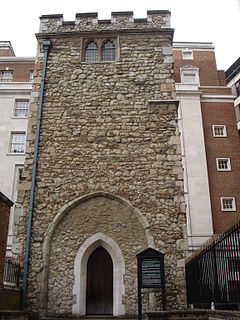
All Hallows Staining was a Church of England church located at the junction of Mark Lane and Dunster Court in the north-eastern corner of Langbourn ward in the City of London, England, close to Fenchurch Street railway station. All that remains of the church is the tower, built around AD 1320 as part of the second church on the site. Use of the grounds around the church is the subject of the Allhallows Staining Church Act 2010.

St Giles-without-Cripplegate is an Anglican church in the City of London, located on Fore Street within the modern Barbican complex. When built it stood without the city wall, near the Cripplegate. The church is dedicated to St Giles, patron saint of lepers, beggars and the handicapped. It is one of the few medieval churches left in the City of London, having survived the Great Fire of 1666.

St Martin Orgar was a church in the City of London in Martin Lane, off Cannon Street. It is sometimes considered being one of the churches mentioned in the nursery rhyme "Oranges and Lemons". Most of the building was destroyed in the Great Fire of London in 1666, but the tower and part of the nave were left standing. The parish was merged with St Clement Eastcheap. The churchyard remained in use by the combined parish until 1853.
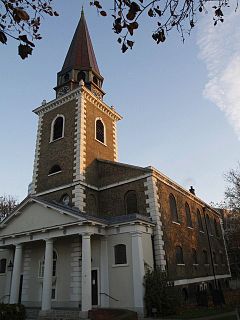
St Mary's Church, Battersea, is the oldest of the churches in Battersea in the London Borough of Wandsworth, in the inner south-west of the UK's capital city. Its parish shared by three Anglican churches is in the diocese of Southwark. Christians have worshipped at the site continuously since around 800 AD. It is a Grade I listed building for its combined heritage and architectural merit.

All-Hallows-the-Great was a church in the City of London, located on what is now Upper Thames Street, first mentioned in 1235. Destroyed in the Great Fire of London of 1666, the church was rebuilt by the office of Sir Christopher Wren. All-Hallows-the-Great was demolished in 1894 when many bodies were disinterred from the churchyard and reburied at Brookwood Cemetery.
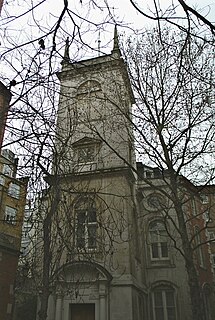
St Olave's Church, Old Jewry, sometimes known as Upwell Old Jewry, was a church in the City of London located between the street called Old Jewry and Ironmonger Lane. Destroyed in the Great Fire of London in 1666, the church was rebuilt by the office of Sir Christopher Wren. The church was demolished in 1887, except for the tower and west wall, which remain today.
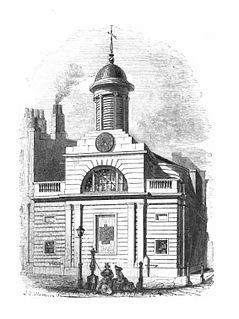
St Martin Outwich was a parish church in the City of London, on the corner of Threadneedle Street and Bishopsgate. Of medieval origin, it was rebuilt at the end of the 18th century and demolished in 1874.

St George Botolph Lane was a church off Eastcheap, in the ward of Billingsgate in the City of London. The rear of the church overlooked Pudding Lane, where the fire of London started. It was first recorded in the twelfth century, and destroyed in the Great Fire of 1666. It was one of the 51 churches rebuilt by the office of Sir Christopher Wren. The church was demolished in 1904.

St Olave's Church, Silver Street was a church on the south side of Silver Street, off Wood Street in the Aldersgate ward of the City of London. It was dedicated to St Olaf, a Norwegian Christian ally of the English king Ethelred II. The church was destroyed by the Great Fire of London in 1666 and not rebuilt.

St Benet Fink was a church and parish in the City of London located on what is now Threadneedle Street. Recorded since the 13th century, the church was destroyed in the Great Fire of London of 1666, then rebuilt to the designs of Sir Christopher Wren. The Wren church was demolished between 1841 and 1846.

St Mary Bothaw was a parish church in the Walbrook ward of the City of London. It was destroyed in the Great Fire of London in 1666 and not rebuilt, although some of its materials were used in the rebuilding of St Swithin, London Stone, whose parish it was merged with.

St Christopher le Stocks was a parish church on the north side of Threadneedle Street in the Broad Street Ward of the City of London. Of Medieval origin, it was rebuilt following the Great Fire of London in 1666, but demolished in 1781 to make way for an extension of the neighbouring Bank of England.

All Hallows, Honey Lane was a parish church in the City of London, England. Of medieval origin, it was destroyed in the Great Fire of London in 1666 and not rebuilt; the site became part of Honey Lane Market, which was in turn partially cleared to make way for the City of London School in the 19th century. Much of the area was destroyed during the bombing in World War II and has been redeveloped. The name Honey Lane is retained in a nearby walkway.

St Alphege or St Alphage London Wall was a church in Bassishaw Ward in the City of London, built directly upon London Wall. It was also known as St Alphege Cripplegate, from its proximity to Cripplegate. It is now operated as St Alphege Gardens.

St Botolph's, Billingsgate was a Church of England parish church in London. Of medieval origin, it was located in the Billingsgate ward of the City of London and destroyed by the Great Fire of London in 1666.
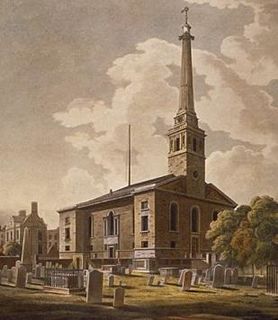
St John Horsleydown was the Anglican parish church of Horsleydown in Bermondsey, South London. Built for the Commission for Building Fifty New Churches to the designs of Nicholas Hawksmoor and John James in 1726–1733, it was noted for its distinctive spire in the form of a tapering column.

St Laurence Pountney was a Church of England parish church in the Candlewick Ward of the City of London. It was destroyed in the Great Fire of 1666, and not rebuilt.

The church of St Laurence, Upminster, is the Church of England parish church in Upminster, England. It is a Grade I listed building. It is the historic minster or church from which Upminster derives its name, meaning 'upper church', probably signifying 'church on higher ground'. The place-name is first attested as 'Upmynster' in 1062, and appears as 'Upmunstra' in the Domesday Book of 1086.

St Mary's Church is the oldest parish church in Hendon in the London Borough of Barnet. The mother church of Christ Church, Brent Street, the two form one parish in the Diocese of London.





















